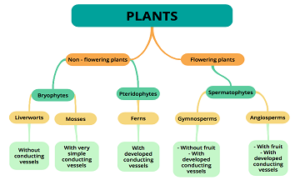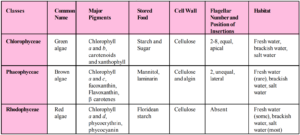Plant Kingdom
Plantae is the plant kingdom which contains all plants on the earth. They are multicellular eukaryotes. Characteristically, they contain a rigid structure that surrounds the cell membrane known as the cell wall. Plants also have a green colored pigment known as chlorophyll that is quite vital for photosynthesis. Hence, they have an autotrophic mode of nutrition. A plant kingdom is a massive group; hence, the kingdom is further categorized into subgroups. The best way to study about plants is to first recognize how the classification takes place within Kingdom Plantae. Once you know the simple stuff, it then becomes easier to be familiar with in detail about each plant.
Artificial System – Based on few characteristics, gave equal weightage to vegetative and sexual characteristics.
No accepted as vegetative characteristics are early affected by the environment.
Natural – Based on natural affinities, both external and internal features, given by George Bentham and Joseph Dalton Hooker.
Phylogenetic classification – Evolutionary relationships, organisms belonging to the same taxa have common ancestors.
Numerical Taxonomy – Carried out using a computer. Number and codes are assigned to all characters, and the data are then processed.
Cytotaxonomy – Cytological information- chromosome number, Structure, behaviour.
Chemotaxonomy – Chemical constituent of the plant.
ALGAE
Chlorophyll bearing, simple, thalloid, autotrophic, found in moist stones, soil etc., occur in association with fungi(lichen) and animals (sloth bear), can be colonial(volvox) or filamentous (Ulothrix and spirogyra).
Reproduction- Vegetative – fragmentation
Asexual – Zoospores(flagellated)
Sexual – a fusion of gametes, flagellated and similar size (Ulothrix), non-flagellated and similar (spirogyra)- isogamous. Anisogamous- dissimilar in size, e.g., Eudorina, Oogamous- one large (non-motile) female and smaller motile male, e.g., Volvox, Fucus.
- Economic importance
Half of the total CO2 fixation is carried by algae through photosynthesis.
Increase O2 level
Porphyra, Laminaria and sargassum are used as food.
Produce hydro collides (water-holding substances), e.g.- Algin (brown) and carrageenan (red)
Agar from Gelidium and Gracilaria are used in ice cream & jellies.
Chlorella is rich in protein, used by space travellers.
Types
Chlorophyceae – (Green Algae)
Unicellular, colonial or filamentous
Pigment – chlorophyll a and b
Chloroplast- Discoid, plate-like, reticulate, cup-shaped, spiral or ribbon-shaped
Pyrenoids – most of them have one or more storage contain starch and protein.
Cell wall – rigid, inner- cellulosic, outer pectose.
Reproduction-
ü Vegetative- fragmentation
ü Asexual – flagellated zoospores in zoosporangia
ü Sexual- isogamous, anisogamous, oogamous. E.g.- Chlamydomonas, Volvox, Ulothrix, Spirogyra, Chara
Phaeophyceae – (Brown Algae)
It may be simply branched, filamentous (Ectocarpus) or profusely branched (kelps)-100 m.
Pigment- chlorophyll a, c, carotenoids, Xanthophyll, fucoxanthin
Food storage – Laminarin or mannitol
Cell wall- has a gelatinous coating of algin
Protoplast- Plastids + vacuole + nucleus
Plant body- Attached to the substratum by holdfast, has a stalk, stips, frond (leaf-like photosynthetic organ).
Reproduction-
ü Vegetative- Fragmentation
ü Asexual- Bi-flagellated zoospores (pear-shaped having two unequal flagella)
ü Sexual- Isogamous, anisogamous, Oogamous. Gametes are pyriform (pear-shaped). E.g.- Ectocarpus, Dictyota, Laminaria, Fucus.
Rhodophyceae – (Red Algae)
Pigment- r-phycoerythrin
Habitat- Warmer areas, lighted region closed to surface of water or at their depth.
Food storage- Floridian starch (similar to amylopectin & glycogen).
Reproduction-
ü Vegetative- fragmentation
ü Asexual- Non- motile spores
ü Sexual- Non-motile gametes, Oogamous then fertilization. E.g., Gracilaria, Gelidium, Porphyria.
BRYOPHYTES
Amphibian of the plant kingdom.
Moist, shaded areas, these are depended on water for sexual reproduction, an important role in plant succession on bare rocks, thallus like, prostrate, attached to the substratum by unicellular or multicellular rhizoids, main plant body is haploid, gametophyte.
Male- antheridium Female- archegonium
- Reproduction
Antherozoids are produced in water where they come in contact with archegonium, fuses forms Zygote, produce sporophyte (not free-living but derives nourishment), undergo reduction division to produce haploid spores, germinate to produce gametophyte.
- Economic importance
Mosses provide food, sphagnum provides peal for fuel and packing material for trans shipment of living material (good water holding capacity), Mosses + Lichens- decompose rocks making substrate suitable for growth, reduce the impact of rain & soil erosion by forming dense mats on the soil.
- Liverworts – E.g., Marchantia
Habitat -banks of streams, damp soil, the bark of trees
Plant body- Thalloid
Reproduction
ü Asexual- Fragmentation or gemmal (green, multicellular asexual buds in gemmal cups), they detach and germinate.
ü Sexual- Sporophyte is differentiated into foot, seta and capsule. After meiosis, spores are produced, germinative to give gametophyte.
- Mosses – E.g.- Funaria, Sphagnum, Polytrichum
Protonema – Gametophyte, develops from a spore, green, creeping, branched stage.
Leafy stage – Upright, slender axis bearing leaves and attached to the soil by multicellular rhizoids.
Reproduction
ü Vegetative- Fragmentation & budding.
ü Sexual- Zygote develops into sporophyte (foot, seta, capsule), capsule contains spores.
PTERIDOPHYTES
Psilopsida (Psilotum), Lycopsida (Selaginella, Lycopodium), Sphenopsida (Equisetum), Pteropsida (Adiantum, Pteris)
- Economic importance – Medicinal purposes and soil binders, ornamentals.
- Feature– Poses vascular tissues (first plants).
- Habitat– Cool, damp, shady places.
- Plant body – Sporophyte (true root, stem and leaves).
Leaves– microphylls (small)- Selaginella or microphyll – ferns.
Sporophylls– leaf-like appendages that subtend sporangia. It may form a compact Structure – strobili or cones.
Prothallus- Photosynthetic thalloid gametophyte, free-living, small produced on spore germination.
- Sexual Reproduction – Male- antheridia, female- archegonia, water is required for transfer of antherozoid to archegonium, leads to Zygote, then spores.
Homosporous – Similar kinds of spores. e.g., Majority
Heterosporous- 2 kinds of spores (micro & macro). E.G.- Selaginella and Saluinia.
- Seed habit– Spores give rise to the gametophyte (heterosporous), development of Zygote take place within females.
- g.- Selaginella, Pteris, Dryopteris.
GYMNOSPERMS
Ovule is not enclosed by an ovary wall
Sequoia – Redwood tree, tallest tree species
Roots– tap root, fungal association (mycorrhiza), e.g., Pinus, coralloid roots are associated with N2- fixing cyanobacteria. E.G., Cycas
Stems -Unbranched, e.g.- Cycas; branched, e.g.- Pinus, Cedrus
Leaves – Simple/compound, in Cycas pinnate leaves, persist for few years, extreme temp, humidity.
Conifers– Needle-like leaf having their cuticle reduce the surface area
Heterosporous – Haploid micro and megaspores.
Strobili – also cones, compact, spiral arrangement of sporophyll to form lax.
Male strobili- Microsporangia, reduced gametophyte- pollen grains, development of pollen grains.
Female strobili- Macrosporangia are bearing ovules.
Ovule– Mother cell differentiate from one of the nuclei which is protected by envelope and composite Structure, borne on megasporophyll which cluster to form female cones, meiosis (4), one of them develop into female gametophyte bearing 2 or more archegonia.
Independent– Male and female gametophytes don’t have an independent existence. Pollen grains are carried by air currents and come in contact with the ovule. Pollen tube carries male gamete and discharges their content near the mouth of archegonia, fertilization-Zygote-Embryo-Ovule.
Click Here for Complete Biology Notes
ANGIOSPERMS
Seeds – Pollen grain/ovule are developed in Structure – flowers.
Range – Smallest- Wolffia, Tall- Eucalyptus (100m).
Commercial– food, fodder, fuel, medicines.
Further division– Dicotyledons and monocotyledons.
Dicotyledons– 2 cotyledons, reticulate venation, tetramerous or pentamerous flowers (4or 5 members in each floral whorls).
Monocotyledons – Single cotyledon, parallel venation, trimerous flower.
Stamen – Filament + anther at the tip, within anther pollen mother cell undergo meiosis – matured into pollen grains.
Pistil- Ovary + style + stigma, each ovule has megaspore are haploid spore, 3 degenerate and one divide to form embryo sac.
Embryo sac – One egg cell + 2 synergids + 8 antipodal cells + 2 polar nuclei.
Pollination – Pollen grains are carried by wind to stigma.
Double fertilization – Pollen grains germinate on stigma and reach ovule, enter embryo sac where 2 male gametes are discharged, one fused with egg to form Zygote, another with the diploid secondary nucleus to form triploid primary endosperm nucleus (PEN). Hence 2 fusions.
After Fertilization – The Zygote develops into Embryo and PEN into endosperm (provide nourishment). Synergids and antipodals degenerate after fertilization.
PLANT LIFE CYCLE AND ALTERNATION OF GENERATIONS
Gametophyte – Haploid plant body
Sporophyte – Diploid plant body
Alternation of generation– Haploid body produces gametes by mitosis, after fertilization, Zygote divides by mitosis to produce diploid body. Haploid spores are produced by meiosis. Then, form haploid plant body.
Haplontic- Meiosis in Zygote results in haploid spores, which divide mitotically and form gametophyte (dominant Photosynthetic phase). E.G.- Volvox, Spirogyra, Chlamydomonas.
Diplontic – Diploid sporophyte in dominant photosynthetic phase. E.g., Algae, Fucus, etc.
Haplo-diplontic – both phases are multicellular.
BRYOPHYTE- Haploid gametophyte, thalloid, erect, photosynthetic. The sporophyte is dependent on the gametophyte for anchorage and nutrition.
PTERIDOPHYTE- Vascular plant body, saprophytic/autotrophic but short-lived haploid gametophyte.
OTHER EXAMPLES– Ectocarpus, Polysiphonia, Kelps; Fucus – Diplontic
Related Posts
- Phylum Porifera: Classification, Characteristics, Examples
- Dissecting Microscope (Stereo Microscope) Definition, Principle, Uses, Parts
- Epithelial Tissue Vs Connective Tissue: Definition, 16+ Differences, Examples
- 29+ Differences Between Arteries and Veins
- 31+ Differences Between DNA and RNA (DNA vs RNA)
- Eukaryotic Cells: Definition, Parts, Structure, Examples
- Centrifugal Force: Definition, Principle, Formula, Examples
- Asexual Vs Sexual Reproduction: Overview, 18+ Differences, Examples
- Glandular Epithelium: Location, Structure, Functions, Examples
- 25+ Differences between Invertebrates and Vertebrates
- Lineweaver–Burk Plot
- Cilia and Flagella: Definition, Structure, Functions and Diagram
- P-value: Definition, Formula, Table and Calculation
- Nucleosome Model of Chromosome
- Northern Blot: Overview, Principle, Procedure and Results

















